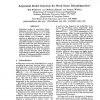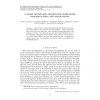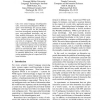366 search results - page 9 / 74 » Subjectivity Word Sense Disambiguation |
COLING
1990
13 years 8 months ago
1990
In this paper, we describe a means for automatically building very large neural networks (VLNNs) from definition texts in machine-readable dictionaries, and demonstrate the use of...
ANLP
1997
13 years 9 months ago
1997
Statistical models of word-sense disambiguation are often based on a small number of contextual features or on a model that is assumed to characterize the interactions among a set...
CSL
2004
Springer
13 years 7 months ago
2004
Springer
This paper explores factors correlating with lack of inter-annotator agreement on a word sense disambiguation (WSD) task taken from SENSEVAL-2. Twenty-seven subjects were given a ...
CORR
2008
Springer
13 years 7 months ago
2008
Springer
Abstract. A large class of unsupervised algorithms for Word Sense Disambiguation (WSD) is that of dictionary-based methods. Various algorithms have as the root Lesk's algorith...
NAACL
2010
13 years 5 months ago
2010
Like most natural language disambiguation tasks, word sense disambiguation (WSD) requires world knowledge for accurate predictions. Several proxies for this knowledge have been in...



